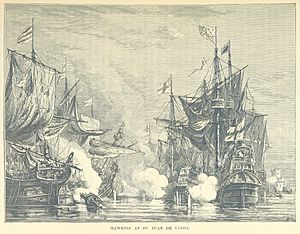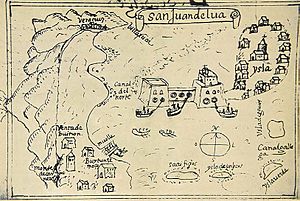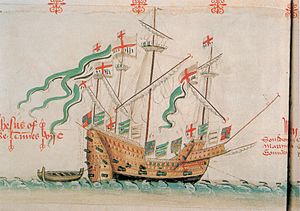Battle of San Juan de Ulúa (1568) facts for kids
Quick facts for kids Battle of San Juan de Ulúa |
|||||||
|---|---|---|---|---|---|---|---|
| Part of the second Anglo-Spanish trade war (1568–1573) | |||||||
 An 1887 illustration of the battle |
|||||||
|
|||||||
| Belligerents | |||||||
| Commanders and leaders | |||||||
| Francisco Luján Juan de Ubilla |
John Hawkins Francis Drake |
||||||
| Strength | |||||||
| 13 ships | 6 ships 400 crew |
||||||
| Casualties and losses | |||||||
| 1 ship 20 killed |
4 ships 320 killed |
||||||
The Battle of San Juan de Ulúa was a sea fight between English and Spanish ships. It happened in 1568 at San Juan de Ulúa, which is now Veracruz, Mexico. The English ships were led by John Hawkins. They were trading in areas that Spain claimed as its own.
Hawkins' fleet of six ships needed repairs and supplies after a storm. They stopped at San Juan de Ulúa. Soon after, two Spanish ships arrived. These ships carried the new Spanish leader for New Spain, Martín Enríquez de Almanza. The English and Spanish leaders agreed to a truce. This truce would let both fleets use the port safely.
However, the Spanish secretly planned to attack the English ships. When the English became suspicious, the Spanish attacked. They captured English cannons on the shore. They also tried to board the English ships. The English fought back at first. But the captured cannons were turned against them. This caused a lot of damage to the English fleet.
Only two English ships managed to escape. The other four were either sunk or captured. The Spanish lost one ship. The English saw this battle as an example of Spanish betrayal. The Spanish, however, believed it was necessary to stop illegal trade. This battle caused a lot of anger. It helped lead to the Anglo-Spanish War which started 17 years later.
Contents
Why the Battle Happened
After explorers found the New World, Spain and Portugal decided to split the new lands. In 1494, they signed the Treaty of Tordesillas. This agreement divided the world into Spanish and Portuguese zones. Spain believed all of North America was theirs.
Later, the Protestant Reformation happened. Protestant countries like England did not agree with the Pope's power. So, they ignored the treaty. English traders began to visit Spanish colonies in the Americas. Spain did not like this. They wanted to control all trade and settlements in their claimed areas.
John Hawkins was an English adventurer. He made trading trips to Spanish colonies in 1562 and 1564. He traded goods for gold, silver, and other valuable items. This trade was against Spanish law. But local Spanish officials often traded with Hawkins anyway. They sometimes took bribes or bought his goods cheaply. Hawkins even got letters from Spanish officials saying he behaved well. But higher Spanish authorities were worried. They ordered English ships to be seized.
Hawkins' third trip had five ships. These included the Jesus of Lübeck (rented from Queen Elizabeth I) and the Minion. His cousin, Francis Drake, commanded the Judith. They sailed to Africa to get enslaved people. Then they sailed to the Americas to sell them. After selling goods in Cartagena, they faced a big storm. The Jesus of Lübeck was badly damaged.
Hawkins needed to repair his ship and get supplies. He decided to go to the nearest port, San Juan de Ulúa. On the way, he met three Spanish ships. He hoped to use them to get better terms for his repairs. Spanish officials first thought Hawkins' fleet was their own. They were surprised to find English ships. Hawkins told them he only wanted supplies and repairs. The Spanish officials were relieved. The next day, two Spanish warships arrived. They carried the new Spanish leader, Don Martin Enriquez.
The Battle Begins
The port at San Juan de Ulúa was very small. It was hard for both fleets to fit. Hawkins sent a message to the Spanish. He wanted to agree on how they would act. This was to avoid a fight.
English privateers had often ignored the Treaty of Tordesillas. But Hawkins expected the Spanish to respect a truce. After two days, both sides agreed to terms. They exchanged hostages. The Spanish fleet then entered the port. The ships of each country were kept separate. The English were allowed to buy supplies and repair their ships. They could also use 11 cannons on the island. The Spanish also agreed not to bring weapons onto the island.
However, the Spanish commander did not plan to keep the truce. He was ordered to stop English trade. The Spanish secretly gathered soldiers on the mainland. Their goal was to capture the cannons on the shore. They also hid 150 men on a large ship called the San Salvador. This ship was to move between the English and Spanish fleets.
The Spanish planned to attack at midday on September 24. A trumpet would sound the attack signal. The English were supposed to be eating lunch. But the English became suspicious. They saw Spanish crews moving weapons. Hawkins sent a captain to ask the Spanish leader to stop. The Spanish leader realized his plan was found out. He ordered the attack to start right away.
Spanish troops quickly rowed to the island. They captured the English cannons on the beach. Many English sailors ran to their ships. This action was very important for the battle's outcome.
The Minion was the first target of the Spanish boarding attack. But it fought off the attackers. The Jesus of Lübeck was also boarded. But the English fought hard and pushed the Spanish back. The French commander of the Grace of God set his ship on fire. He did this to stop the Spanish from capturing it. Then he joined Hawkins on the Jesus of Lübeck. The English fired back at the Spanish. One Spanish ship, the Santa Clara, caught fire and sank. The main Spanish ship, the San Pedro, was also badly hit.
By now, the Spanish controlled the shore cannons. They turned these cannons on the English ships. The Jesus of Lübeck was badly damaged. It lost its masts. The English moved the Jesus of Lübeck to shield the Minion. This allowed the Minion to move out of range. The Angel sank quickly. The Swallow was captured by Spanish soldiers. Hawkins ordered his men to leave the damaged Jesus of Lübeck. He then took command of the Minion.
Only the Judith, led by Drake, and the Minion escaped. The Jesus of Lübeck was left behind with some crew still on board. The Spanish sent two fire ships after the escaping English ships. But they caused no damage. During the night, Francis Drake on the Judith left the fleet. He sailed home, leaving Hawkins alone. The Minion was very crowded and low on supplies. The Spanish later captured the drifting Jesus of Lübeck.
What Happened to the Abandoned Crewmen
The Minion and Judith were very crowded and low on food and water. Hawkins had to leave 114 crew members on the Mexican coast. These men faced many dangers. They were attacked by local tribes. Then, Spanish soldiers captured them. They were imprisoned in Tampico and later moved to Mexico City.
At first, the Spanish treated them fairly well. Some were even released. They started farming and families. But three years later, in 1571, the Mexican Inquisition arrived in Mexico. The Inquisition was a religious court. It rounded up the released crewmen. The captives were brought before the Inquisition. Those who were under 16 at the time of the battle were treated more kindly. For example, Miles Philips was sent to a religious house for three years.
The older crewmen were seen as having left the Catholic faith. In 1574, after being questioned, they received harsh sentences. Some were sentenced to years of hard labor on Spanish ships. Others faced very severe punishments.
After the Battle
Hawkins finally returned to England with only 15 crew members. Drake had arrived a month earlier. Only about 70 or 80 sailors from the original trip made it back to England.
Hawkins said the Spanish were traitors for breaking the truce. Don Enrique, the Spanish leader, said he was just doing his job. He was upholding Spain's control over trade in the Americas.
For many years, Englishmen remembered the Battle of San Juan de Ulúa. They saw it as a terrible example of Spanish betrayal. Drake's decision to leave Hawkins during the battle affected him deeply. It made him even more determined against the Spanish.
The battle was an important event before the war started. That war broke out 17 years later between Philip II of Spain and Elizabeth I of England.
|
See also
 In Spanish: Batalla de San Juan de Ulúa para niños
In Spanish: Batalla de San Juan de Ulúa para niños



